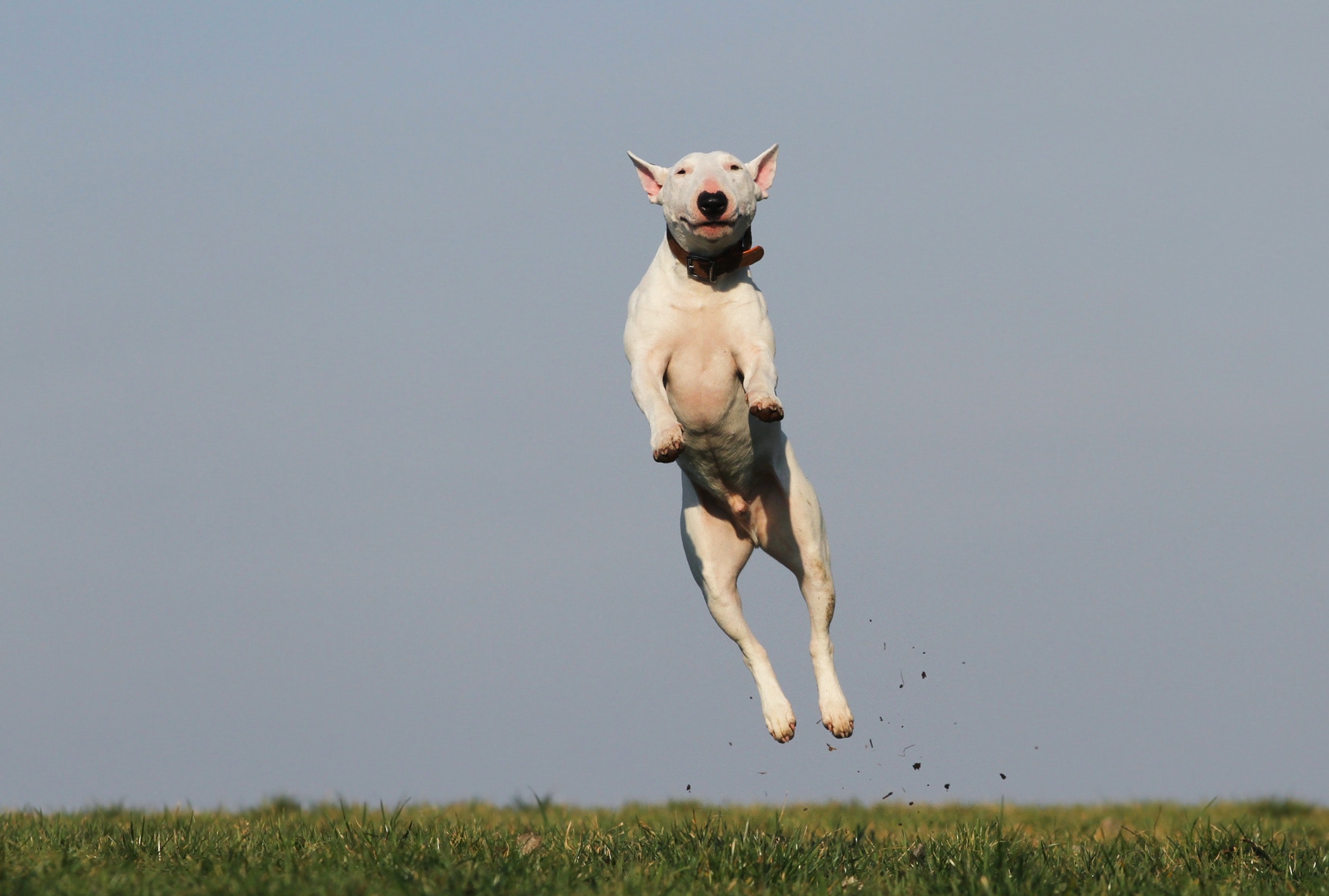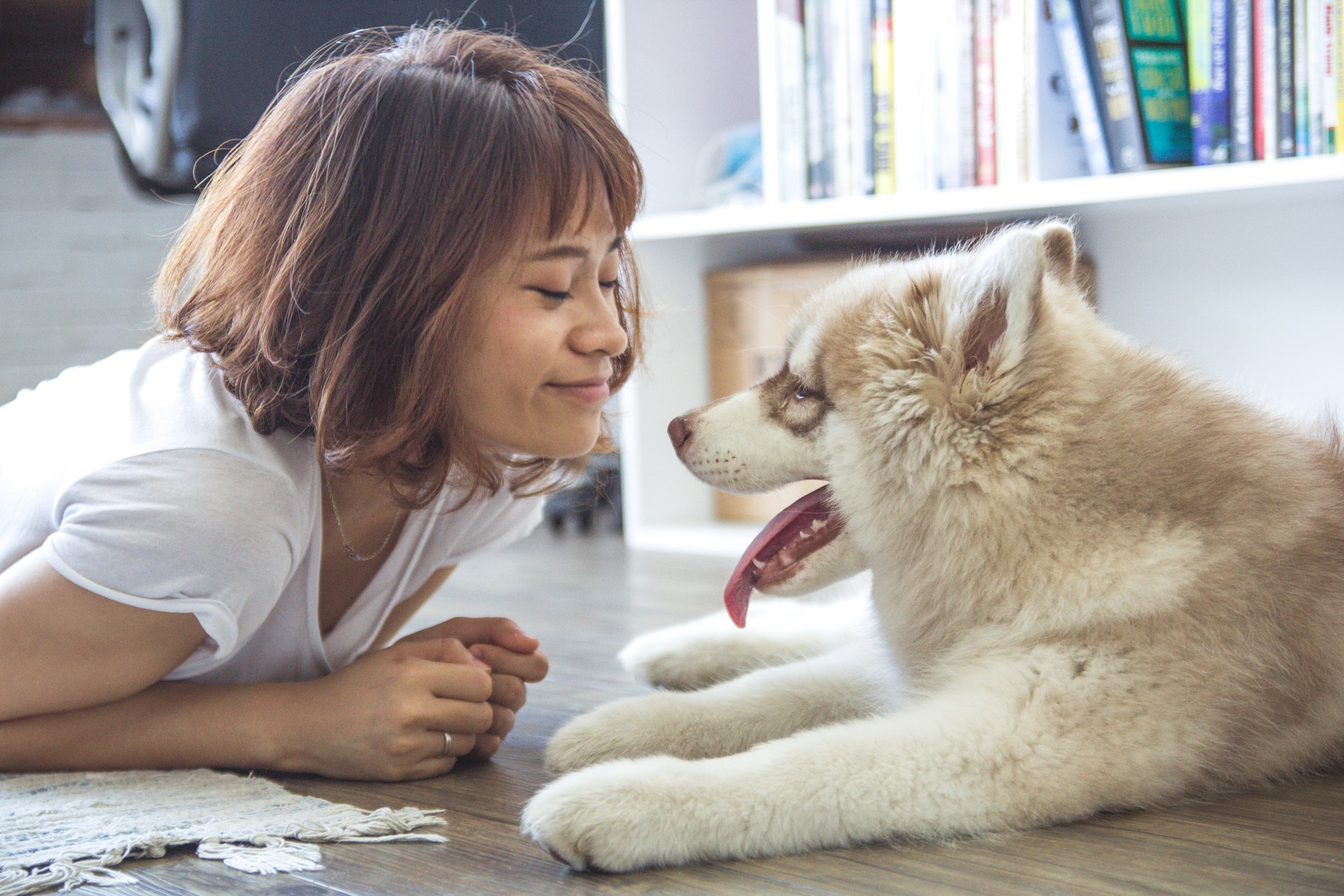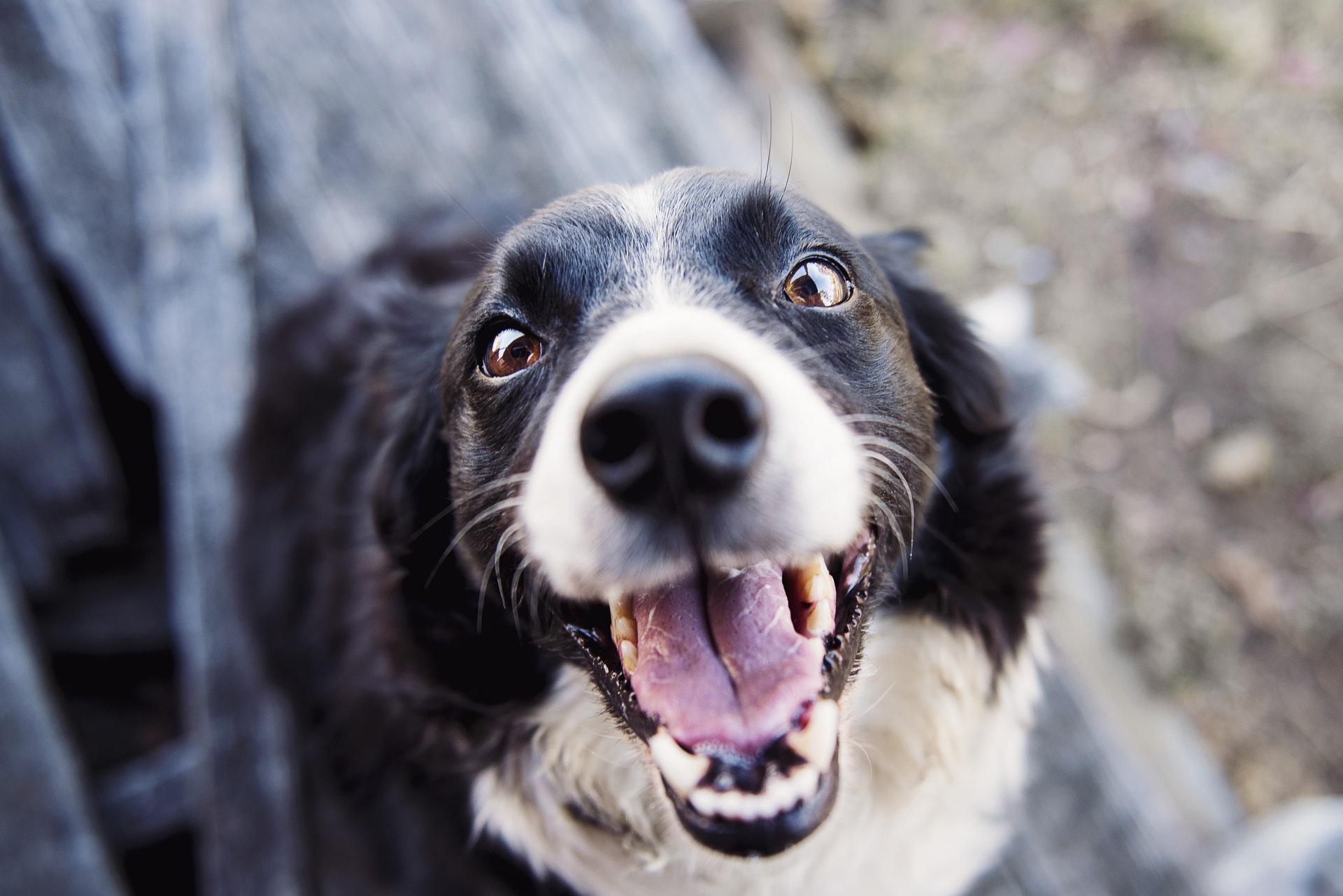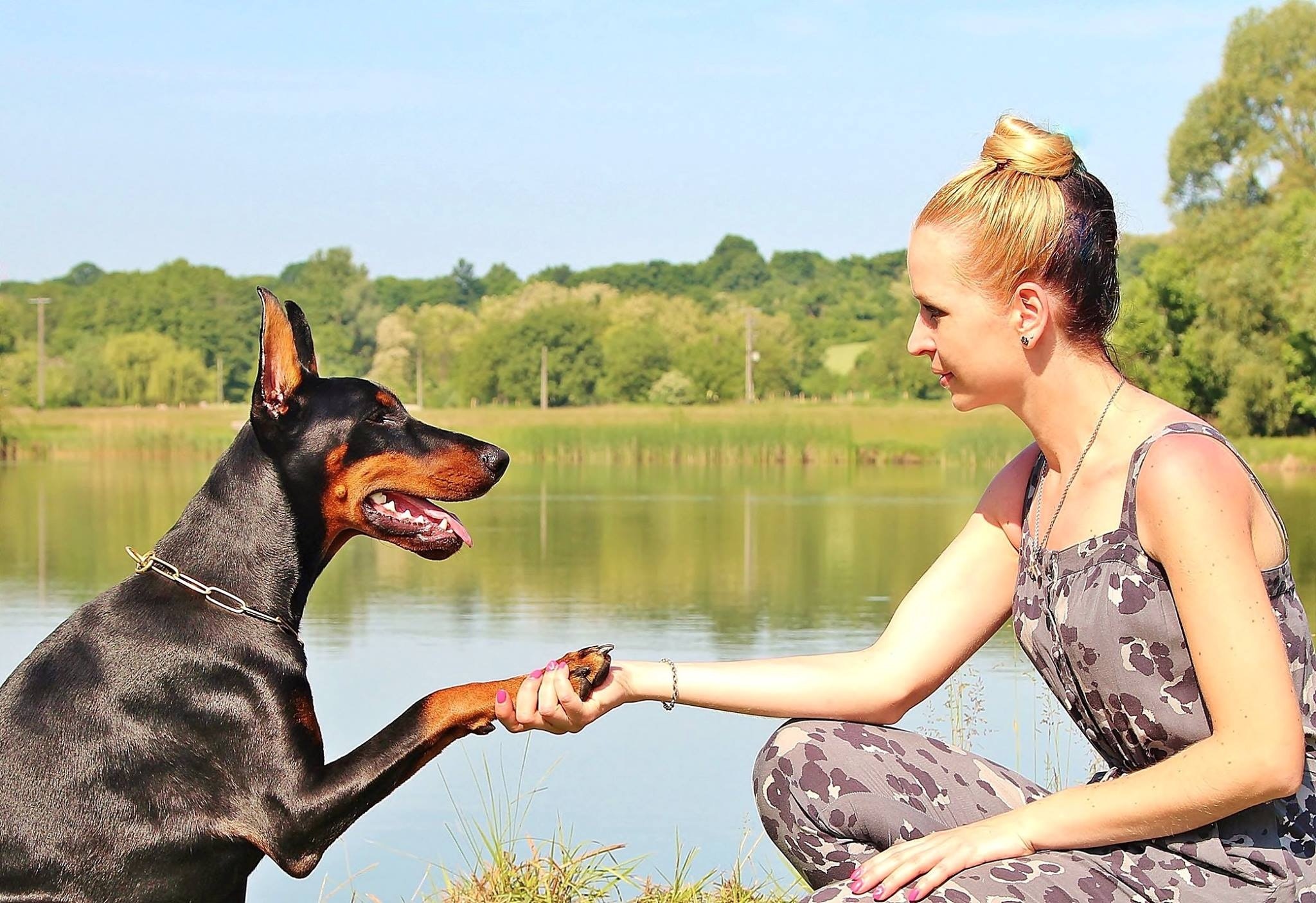Watch The Video Below To Learn How To Train A Dog Not To Jump
Click Here To Visit The Online Dog Trainer
Jumping comes naturally to dogs.
After all, in the days before domestication, it played an essential role in their ability to hunt and escape.
However, the problem facing today’s pooches is that around 65% of dogs will develop arthritis in later life.
Unnecessary jumping is a key contributing factor towards this alarming statistic, and even worse it is something that with a little training can largely be prevented.
In order to train dogs to avoid jumping behavior – be it at people, furniture or any other context – ideally we want to introduce that training during their puppyhood socialization.
Older dogs can also be helped too, and in this article, we’ll first explore the reasons and motivations for why dogs are so inclined to perform this unwanted behavior.

What Are The Main Reasons For Dogs Jumping?
In every scenario we’ll look at in this section there is one constant fact that applies to each.
Dogs jump up because they want something.
Or they simply wish to be closer to whatever it is they desire.
Perhaps it is for attention, so they leap up at their owners.
Maybe a favorite toy is out of reach so they try to hop up onto furniture.
And more likely than not, they will jump at the sight of their meals being prepared, not often so much due to hunger but because of sheer excitement.
All of these are simply natural impulses that are part and package of being a dog.
And hope as you may, this behavior will not go away on its own, so it is down to the owner to work out a consistent and patient strategy to lessen or even completely remove that instinct.
Related: 5 Step-By-Step Calming Exercises To Quickly & Easily Stop Your Dogs Obsessive Jumping Habit

Dogs Jumping Up As A Greeting
Most owners will be all too familiar to come from a long day at work and then to be half-mauled by their terrifically excited canine buddy!
It can become a routine chore, especially after a tough day, and is one of the most common reasons for even the best owners to just lose their temper.
Obviously, this is something best avoided and will serve to confuse and frustrate your dog.
Most probably their reaction will be along the lines of “my owner doesn’t think I love them enough” so they’ll just try harder.
Pretty unproductive reaction all round!
Why do dogs do this to their owners and often visitors/strangers also?
Once again it comes down to their natural programming.
Dogs greet and check out each other by going up nose to nose. All your dog is doing by jumping up at you is wanting to gaze longingly into your eyes. But that isn’t always appropriate, so we need to look into a training schedule where they’re happy to gaze up but not touch.
Of course, this is especially important should you have kids or frail people within your household (or as the dog considers it, pack).
Jumping Due To Anxiety
Anxiety is far more prevalent in dogs than most owners care to appreciate.
Separation anxiety is perhaps the most common and best-known example, and your dog may become extremely attention seeking out of sheer relief that their pack has returned home.
Jumping up will likely be a cause of this, not just out of that relief but also in the more pressing sense of “please don’t do that again”.
There’s also a good chance they will be hungry so when they see you start preparing their meal there’s an even higher likelihood that they’ll become overexcited and start jumping up.
There are many other causes of dog anxiety and identifying them isn’t always as easy as we’d like.
Whatever it is that is causing your dog stress may well lead to excessive jumping as a way for them trying to ask you to do something about it.
When you don’t comprehend or act, it will over time affect your dog’s confidence in you as their leader and quite possibly cause further behavioral problems.
Related: 5 Step-By-Step Calming Exercises To Quickly & Easily Stop Your Dogs Obsessive Jumping Habit

Jumping At Strangers
Many dogs are extremely calm and settled around their home (den) but when they interact with a stranger they’ll often be prone to investigate them further.
As mentioned above, eye to eye contact is a big deal for dogs, but this is not necessarily an ideal situation for the owner.
For example, if your dog is great at walking on the leash but you turn a corner and all of a sudden it’s trying to leap at a passing stranger, then that’s a problem which needs addressing by appropriate training.
The same is true for unfamiliar dogs especially when one breed is significantly larger than the other.
Having your great Terrier leaping up at a Great Dane is not a behavior that ought to be encouraged, no matter how chilled the other dog is about it.
The Danger Of Dogs Jumping
Our main concern about dogs jumping has to be the risk of immediate and long term injury.
Excitable dogs and some breeds such as Collies and Greyhounds are notorious for it.
And even worse, they will become so hyperactive that they can be prone to looking before they leap.
Naturally, this raises the risk of say running into a busy road, landing on a dangerous object, or simply losing their bearings and becoming lost.
There is also the aforementioned risk of your dog inappropriately jumping up on someone.
You need to remember that not everyone is as fond of dogs as me and you.
Some people are more aggressive than others.
And a minority of people may kick out at dogs and perhaps even follow through that aggression on their owner.
In a similar vein, should your dog leap at someone frail (elderly/small kid) and knock them over it can become a serious problem.
Your Responsibility
 Remember that you are liable for your dog’s actions and in serious cases, it can lead to severe litigious consequences.
Remember that you are liable for your dog’s actions and in serious cases, it can lead to severe litigious consequences.
Any dog owner will know how unpredictable it can be when introducing your dog to others.
Some dogs (largely regardless of breed) are more difficult to socialize with others effectively.
So while one dog may be happy and confident, the reaction of the other is never to be taken as 100% certain, especially when there is a physical mismatch.
Last but not least there is the simple fact that dogs prone to jumping up are inevitably likely to cause damage to property.
Scratch marks to furniture, walls, fittings, fences, and vehicles are going to happen.
When Fido knocks over and damages an expensive/valued item it may cause even the most patient of owners enough distress to take it out on their dog.
This is always going to be counteractive and will in most cases lead to the development of further problems.
Related: 5 Step-By-Step Calming Exercises To Quickly & Easily Stop Your Dogs Obsessive Jumping Habit
How To Train A Dog Not To Jump
So now we have identified the numerous reasons why dogs may jump.
So how do we do about preventing it?
Well, the first step is for owners to accept that lovely as it may be to have your dog show their affection by jumping around, in the long term it is likely going to cause issues.
It is certainly going to make younger dogs more difficult to train if jumping behaviors are left unchecked.
Yet many of the most useful tips for counteracting this behavior are extremely useful in future training.
Having a dog which obeys these rules and understands the consequences for inappropriate behavior is a huge boost further down the line.
The Two Essential Principles
We’ll discuss a few practical methods shortly but it is important to identify the two simple rules that are consistently applicable to this kind of training:
- Never respond to jumping
- Reward when four paws are on the floor
For example, if it is dinner time and your dog starts to jump up either on yourself or the furniture, simply stop what you are doing.
Do not pay them any attention whatsoever – not even a glance. Consider putting the food back into the cupboard or otherwise out of reach and do something else.
After a few minutes go through the motions again.
It can take several repetitions until your dog understands that staying prone = dinner time.
Repeat this consistently and without exception and before long it will be accepted as second nature.
Should your dog be liable to jump up when excited, say on a walk for example, then just stand still.
They will not carry on jumping for long.
Once they stay prone for 10 seconds, give them a treat and carry on.
Repeat every time they jump up, and gradually prolong the reward for 15, 20, 25… seconds.
It is good to vocalize this when giving an award and consider adding a command such as “Sit”/”Stay” further down the line.
Your dog will come to understand that consistently good behavior earns treats.
But just remember to give them quite frequently otherwise they may start playing up again.
#1 – Correcting Greeting Jumps
This is very useful training for both when you come home and for when you have visitors at the door.
In the first instance, when you arrive outside your door chances are your dog will be either up at the nearest window or at the door itself.
It knows you are there and is waiting to pounce!
The way to avoid this is to simply wait outside and stay silent (it’ll know you are still there).
When it has relaxed then go in and reward prone behavior – unless it jumps up.
Then, difficult as it may be, do not acknowledge the dog until it is calm. When it has done so for 30 seconds, give a treat.
This also works well for barking and often the two behaviors will present themselves at the same time.
Your dog will learn that dignified behavior and controlling their excitement equates to swifter rewards and petting.
Should you have guests arrive outside then a good way of educating your dog to relax/not jump is to put them on their leash.
Keep it short and do not open the door before it has settled.
Provide a toy – ideally a puzzle with treats inside so it will focus attention on the floor rather than towards these interesting visitors.
An alternative is to use a crate or even isolate your dog, but it is better to teach them how to stay relaxed among guests naturally.
Especially if you regularly have people dropping by.
#2 – Learning To Ignore Jumping
 While this is associated with the introduction to this section, there are ways where this behavior can be trained by prompting your dog to jump.
While this is associated with the introduction to this section, there are ways where this behavior can be trained by prompting your dog to jump.
Invite some strangers over but brief them to absolutely ignore the dog when they jump.
When everyone just stands silently still when they are jumping about. It will serve to significantly communicate the message that nobody is going to be any fun while they do so.
In some cases, especially with naturally sociable dogs, this can serve as a fantastic training exercise which may lead to very swift results after just a couple of repetitions.
Remember to also brief every member of your household how to discourage this behavior.
It only takes one or two slip-ups to be straight back to square one.
As always, the magic words are consistency and repetition.
Do not let dogs jump up on sofas/beds.
If they are allowed up, then simply pick them up.
Should they do so on their own volition then it may be worth temporarily isolating them from that room.
Related: 5 Step-By-Step Calming Exercises To Quickly & Easily Stop Your Dogs Obsessive Jumping Habit

#3 – Get On All Fours!
Ridiculous as it may sound, spending a little time at your dogs level can play a useful role in dissuading jumping.
Just play your favorite games from a prone position.
Retrieval training is particularly good for this. As when you dog returns with the stick/ball they will not automatically be inclined to jump up in order to alert you that they want to go again.
Roughhousing with dogs, especially puppies is not generally advisable, so keep to playtime interactions that involve little physicality.
The less your dog feels the need/compulsion to touch you the less they will tend to jump up.
Ideally, the objective is to instead get them used to enjoy your scent.
Once they get the hang of this, it should mean that when you get home, they will be satisfied with a quick sniff of the palm. Instead of wanting to jump and stare you in the eye for attention.
Final Thoughts
Even the most physical and excitable dogs can learn how to associate jumping with bad behavior.
Most will not go out of their way to rile you up on purpose but instead jump for a need/desire.
It is your job to satisfy this, or alternatively, take action in a way that helps them understand that it is not appropriate behavior.
Just like all other forms of training, the key is consistency.
Dogs are smart and will learn by repetition and experience even if it takes dozens or hundreds of attempts to get the message over effectively.
Should you seem to hit a brick wall and Fido continues to jump after months of being told not to, then take the time to evaluate what could be causing this.
Chances are it will be a problem related to either boredom, anxiety or separation.
Try introducing more exercise and playtime, or even dog socialization lessons run through a local canine club.
And if all else fails, take a look through the extensive library of video training available at The Online Dog Trainer.
So, have you any tips for how to train a dog not to jump? Feel free to add your experience in the comments below…